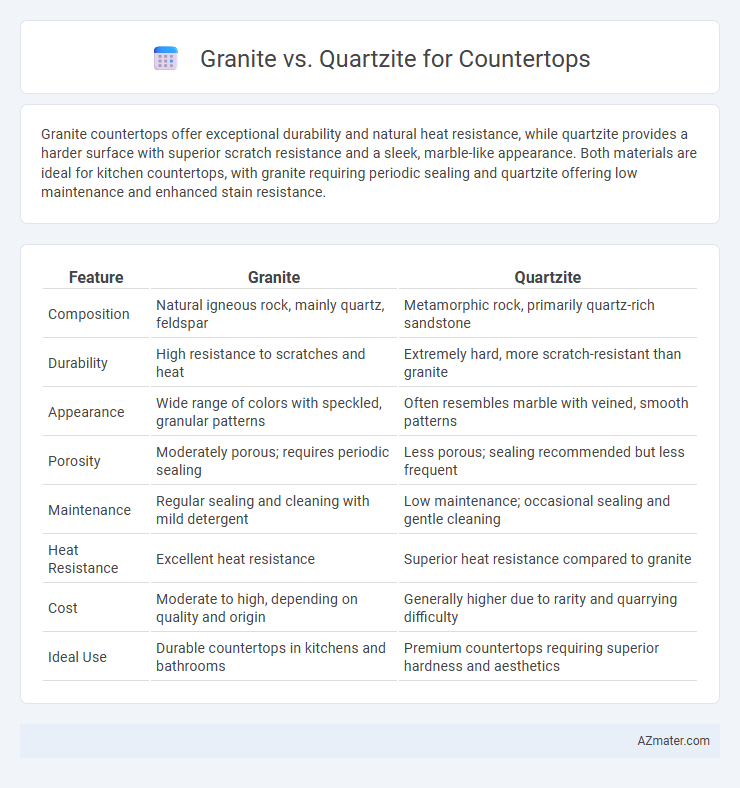Granite countertops offer exceptional durability and natural heat resistance, while quartzite provides a harder surface with superior scratch resistance and a sleek, marble-like appearance. Both materials are ideal for kitchen countertops, with granite requiring periodic sealing and quartzite offering low maintenance and enhanced stain resistance.
Table of Comparison
| Feature | Granite | Quartzite |
|---|---|---|
| Composition | Natural igneous rock, mainly quartz, feldspar | Metamorphic rock, primarily quartz-rich sandstone |
| Durability | High resistance to scratches and heat | Extremely hard, more scratch-resistant than granite |
| Appearance | Wide range of colors with speckled, granular patterns | Often resembles marble with veined, smooth patterns |
| Porosity | Moderately porous; requires periodic sealing | Less porous; sealing recommended but less frequent |
| Maintenance | Regular sealing and cleaning with mild detergent | Low maintenance; occasional sealing and gentle cleaning |
| Heat Resistance | Excellent heat resistance | Superior heat resistance compared to granite |
| Cost | Moderate to high, depending on quality and origin | Generally higher due to rarity and quarrying difficulty |
| Ideal Use | Durable countertops in kitchens and bathrooms | Premium countertops requiring superior hardness and aesthetics |
Introduction: Granite vs Quartzite Countertops
Granite and quartzite are both popular natural stone choices for countertops due to their durability and aesthetic appeal. Granite is an igneous rock known for its wide range of colors and speckled patterns, while quartzite is a metamorphic rock prized for its glassy finish and strength. Homeowners often compare these materials based on hardness, maintenance needs, and resistance to heat and scratches when selecting countertops.
Composition and Natural Formation
Granite is an igneous rock primarily composed of quartz, feldspar, and mica, formed through the slow crystallization of magma beneath the Earth's surface. Quartzite originates as sandstone that undergoes metamorphism, where intense heat and pressure fuse quartz grains into a dense, durable rock. The mineral composition in quartzite is predominantly quartz, making it harder and more resistant to chemical weathering compared to granite's mixed mineral content.
Appearance and Color Variations
Granite countertops offer a wide array of natural color variations, ranging from warm earth tones to vibrant greens and reds, with unique speckles and veining patterns that create a dynamic appearance. Quartzite features a more consistent and softer color palette, typically showcasing shades of white, gray, and beige with subtle, flowing veins that resemble marble. Both materials provide distinctive aesthetics, but granite's bolder color diversity contrasts with quartzite's elegant, muted tones for countertop surfaces.
Durability and Hardness Comparison
Granite and quartzite are both highly durable natural stones ideal for countertops, with quartzite generally ranking higher on the Mohs hardness scale, typically between 7 and 8, compared to granite's 6 to 7. Quartzite's superior hardness makes it more resistant to scratches and etching, though granite offers excellent resistance to heat and moderate durability against impact. Both materials require proper sealing for stain resistance, but quartzite's dense composition provides enhanced longevity and toughness in high-use kitchen environments.
Maintenance and Cleaning Requirements
Granite countertops require periodic sealing to maintain their resistance to stains and bacteria, with cleaning best done using mild soap and water or specialized granite cleaners. Quartzite, though harder and more durable, still benefits from regular sealing to preserve its polished surface and prevent etching from acidic substances, cleaned effectively with non-abrasive, pH-neutral cleaners. Both materials demand prompt spill management and avoidance of harsh chemicals to ensure longevity and retain their natural beauty.
Stain and Heat Resistance
Granite countertops exhibit excellent heat resistance, comfortably withstanding temperatures up to 1,200 degrees Fahrenheit without damage, making them ideal for kitchen use. Quartzite offers superior stain resistance compared to granite due to its dense crystalline structure, reducing the likelihood of discoloration from spills. Both materials require proper sealing to maintain their resistance properties, but quartzite generally demands less frequent sealing to retain its stain resistance.
Cost and Value Considerations
Granite countertops typically cost between $40 to $60 per square foot, offering a durable and affordable option with natural variations that enhance home value. Quartzite, priced higher at approximately $70 to $100 per square foot, provides superior hardness and resistance to heat and scratches, justifying the investment with increased longevity and luxury appeal. Homeowners seeking a balance between cost-effectiveness and high-end durability often consider granite for budget-friendly projects, while quartzite is preferred for premium installations that maximize resale value.
Installation Process and Challenges
Granite countertops require professional installation due to their heavy weight and need for precise cutting and sealing to prevent stains and cracks. Quartzite, although similar in appearance to granite, demands specialized tools for cutting and polishing because of its extreme hardness, making the installation process more challenging and time-consuming. Both materials present challenges such as ensuring proper support for their weight and sealing edges, but quartzite's brittleness increases the risk of chipping during installation.
Environmental Impact and Sustainability
Granite countertops are sourced through quarrying, which involves significant land disruption and energy-intensive processes, but they are durable and long-lasting, reducing the need for frequent replacement. Quartzite, a natural metamorphic rock, often requires less processing than engineered quartz but more than granite, with mining impacts varying by location and extraction methods. Both materials offer sustainability advantages due to their longevity and recyclability, yet granite generally has a lower embodied energy footprint when compared to engineered quartz alternatives.
Choosing the Best Option for Your Home
Granite countertops offer exceptional durability and a wide range of natural color patterns, making them a popular choice for homeowners seeking a classic, heat-resistant surface. Quartzite, a metamorphic rock that is harder than granite, provides a sleek, marble-like appearance with superior scratch resistance for a high-end aesthetic. Choosing the best option depends on your priorities: granite excels in affordability and maintenance ease, while quartzite boasts enhanced durability and unique visual appeal for long-term investment.

Infographic: Granite vs Quartzite for Countertop
 azmater.com
azmater.com